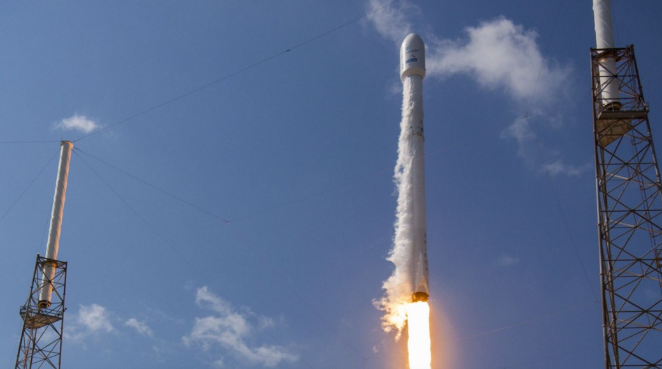An Intergalactic Home Address is on the Horizon
Colonizing other planets used to be the stuff of science fiction. If SpaceX has its way, a neighborhood on Mars is within our sights.
The event in Guadalajara, Mexico, had all the trappings of a Silicon Valley product exhibition — a darkened auditorium, an audience of adoring fans, and a keynote speaker with megawatt charisma showing off a slick PowerPoint presentation.

The difference being, that speaker — SpaceX CEO Elon Musk — wasn’t stepping out to show off a new laptop or revolutionary smartphone. “What I really want to achieve here,” he said in his opening statement at last September’s International Astronautical Congress, “is to make Mars seem possible — something we can do in our lifetimes. And you can go.”
Musk is known for making such bold promises; he’s the same guy who made electric cars sexy again as the owner and CEO of Tesla and who revolutionized digital banking with PayPal. There’s a reason he’s reported to be Robert Downey Jr.’s model for portraying the overconfident genius billionaire Tony Stark. But unlike IronMan and his flying suit, Musk’s plans will require far more than CGI magic to bring them to life within a decade.
Last April, SpaceX took another big step toward making Mars colonization a reality by 2026 — its intended deadline — with the successful landing of a Falcon 9 booster rocket on a drone ship in the Atlantic Ocean. On a typical mission, the booster rocket — which provides the primary source of thrust — would simply fall back to Earth and splash into the salt water after propelling the launch vehicle into orbit. The corrosion would render it unusable for future missions.
 The revolutionary SpaceX Falcon 9 launches skyward. | Source: SpaceX Falcon 9 site
The revolutionary SpaceX Falcon 9 launches skyward. | Source: SpaceX Falcon 9 siteThe Falcon 9, however, is able to burn its remaining fuel reserves during this descent period and gradually lower itself back onto a drone ship’s landing pad. This means SpaceX can use one rocket multiple times — drastically cutting down on the cost per mission. This development factors into Musk’s long-term plans in a critical way. “If reusable rockets drive down the cost of launch, we’ll see more launches, more rapid technology advancement, and ultimately more demand that can sustain an economy beyond Earth,” says Mason Peck, Ph.D., associate professor in the Department of Mechanical and Aerospace Engineering at Cornell. “We’ll do better — explore more, discover more — as spacecraft engineering comes to resemble successful examples like consumer electronics and automotive manufacturing.”
That’s not necessarily a job SpaceX will be able to do entirely on its own — and there are already early signs that the company is willing to collaborate with related agencies and manufacturers. Last April, for instance, they announced a partnership with NASA in which the government will provide technical support for upcoming missions in exchange for data. In 2015, SpaceX also accepted a $1 billion investment from Google and Fidelity — Google, it’s worth noting, also owns Skybox Imaging, a company that manufactures high-resolution satellites. Going forward, they could also explore partnerships with companies like Texas-based Nanoracks, which is already operating a laboratory in space, or Las Vegas-based Bigelow Aerospace, which builds lightweight, durable space habitats. So far, though, there is no evidence to suggest those partnerships have been explored.
But for Mars colonization to be truly realistic, Musk concedes that SpaceX will also need to build one of the largest spacecraft in history — one capable of carrying hundreds of people, as well as enough cargo to sustain a small colony.
Just to achieve orbit, that means SpaceX would need a rocket more powerful than the Saturn V used on the moon missions, which was retired in 1973. Even then, the shuttle would still need a significant amount of fuel to begin its journey to Mars. Musk hopes to solve this problem by having that same booster rocket detach, return to Earth multiple times to refuel, and then bring spare fuel back to the shuttle.
There are obvious concerns surrounding this plan — chief among them that SpaceX’s technology, while impressive, has already been shown to be far from foolproof. Last September, a Falcon 9 rocket burst into flames as it lifted off . The ensuing combustion destroyed all of its cargo. (Thankfully, no people were harmed, and investigators are still looking into the source.) “The explosion is definitely a concern,” says Michael Shara, Ph.D., curator of the Department of Astrophysics at the American Museum of Natural History. “But remember that lots of early NASA rockets exploded, too.”
Critics, meanwhile, have also begun to cast doubts on Musk’s ambitious timeline and relatively conservative budget. “The proposed cost of $10 billion should be multiplied by at least a factor of 10,” says Adam Bruckner, Ph.D., a professor at the University of Washington’s Department of Aeronautics and Astronautics.

“People forget that Mars has a hostile environment, colder than Antarctica,” adds Bruckner, “with a thin, mostly-C02 atmosphere that doesn’t block UV radiation.”
Given the scope of SpaceX’s ambitions, setbacks and cost overruns may be inevitable. Through trial and error, Musk and his engineers no doubt hope to foolproof the launch process over the next decade, while honing their financial projections. In the meantime, they’ll remain focused on their more immediate goals, which include the development of the company’s most powerful rocket, the Falcon Heavy, expected to launch in early 2017.
If that goes as planned, it would keep SpaceX on track for its most ambitious short-term goal — the launch of its Red Dragon space capsule in 2018, an unmanned mission that will serve as its first official attempt to safely land a spacecraft on the surface of Mars. It will also be a make-or-break moment for Musk to prove that he’s able to deliver on what may be the biggest promise to humanity that anyone has made this century.
